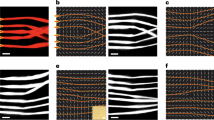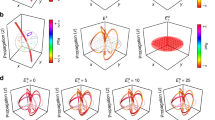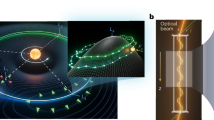Dark lines within a laser beam can be manipulated to form stable vortex knots.
Abstract
Destructive interference may lead to complete cancellation when light waves travelling in different directions cross, and in three-dimensional space this occurs along lines that are vortices of electromagnetic energy flow1. Here we confirm theoretical predictions2,3 by experimentally creating combinations of optical laser beams in which these dark threads form stable loops that are linked and knotted.
Similar content being viewed by others
Main
Since Kelvin proposed his vortex atom hypothesis4, temporally persistent vortex knots have been sought in fluid mechanics5,6, superfluid flow7, field theory8 and nonlinear excitable media9. The optical vortices that we synthesize here are embedded in light beams created by a single-frequency laser (Fig. 1a; for methods, see supplementary information). A direct consequence of the linearity of Maxwell's equations for the electromagnetic field is that the intensity pattern in free space is static, so our optical vortices are stable in both space and time.
a, Light from a hologram is passed through a spatial filter and a camera images the beam cross-section in various planes. Thin black lines represent the threads of darkness that form the link or knot. Inset shows the observed oversaturated beam cross-sections at the beam waist of the link; dark points indicate positions where the optical vortex threads cross the observation plane. b,c, Three-dimensional representations of measured link (b) and trefoil knot (c) configurations. The link and knot are threaded by further vortices (represented by the thinner tubes) that follow the axis of the light beam.
The optical phase cannot be defined on these dark threads: it is singular there (like the angle of longitude at the North Pole, for example). Consequently, there is a circulation of electromagnetic energy around the optical vortex. Around such a singularity, the phase changes by an integer multiple of 2π; this integer, m, is the strength of the singularity.
We combine Laguerre–gaussian beams10, which have an optical vortex of integer strength m along the beam axis and two further variable parameters: p, the discrete radial number (the number of nodal rings about the beam axis), and w, the continuous waist width (which sets the transverse scale of the beam). These additional degrees of freedom allow us to create the same basic structures as those proposed in refs 2 and 3, but with the vortices more clearly defined by the surrounding intensity.
The loops, links and knot structures arise from the coaxial superposition of four beams. Three of these beams have an on-axis vortex with the same strength m, but different values of p and w. The amplitudes are chosen so that both the field and its radial derivative are zero at a specific radius in the focal plane. The resulting destructive interference forms a dark loop around the axial strength singularity. Adding a simple gaussian beam with small amplitude distorts this loop into an (m, 2) torus knot11, threaded by an m-stranded helix of strength-one vortices. If m = 2, the vortices form two linked loops (Fig. 1b); if m = 3, they form a trefoil knot (Fig. 1c).
Our optical beams are produced by using a single-frequency helium–neon laser beam illuminating a hologram. This forms the intensity and phase structure of the desired superposition of Laguerre–gaussian beams. As the fine structure of the singularities lies in regions of near darkness, it is necessary to oversaturate the camera to determine their positions in the beam cross-section accurately. The resulting image contains points of darkness corresponding to the positions of the dark threads as they intersect the plane of the camera.
We have produced stable link and knot structures formed from vortices in an optical beam. Our observations demonstrate the precision control of light beams that is required to create complex regions of zero light intensity. Such regions could be used, for example, to confine cold atoms and Bose–Einstein condensates in complex topologies12.
References
Nye, J. F. & Berry, M. V. Proc. R. Soc. Lond. A 336, 165–190 (1974).
Berry, M. V. & Dennis, M. R. Proc. R. Soc. Lond. A 457, 2251–2263 (2001).
Berry, M. V. & Dennis, M. R. J. Phys. A 34, 8877–8888 (2001).
Thompson, W. Phil. Mag. 34, 15–24 (1867).
Moffatt, H. K. J. Fluid Mech. 35, 117–129 (1969).
Ricca, R. L., Samuels, D. C. & Barenghi, C. F. J. Fluid Mech. 391, 29–44 (1999).
Poole, D. R., Scoffield, H., Barenghi, C. F. & Samuels, D. C. J. Low Temp. Phys. 132, 97–117 (2003).
Fadeev, L. & Niemi, A. J. Nature 387, 58–61 (1997).
Winfree, A. T. Nature 371, 233–236 (1994).
Allen, L., Beijersbergen, M. W., Spreeuw, R. J. C. & Woerdman, J. P. Phys. Rev. A 45, 8185–8189 (1992).
Adams, C. C. The Knot Book (Freeman, New York, 1994).
Ruostekoski, J. & Anglin, J. R. Phys. Rev. Lett. 86, 3934–3936 (2001).
Author information
Authors and Affiliations
Corresponding author
Ethics declarations
Competing interests
The authors declare no competing financial interests.
Supplementary information
Rights and permissions
About this article
Cite this article
Leach, J., Dennis, M., Courtial, J. et al. Knotted threads of darkness. Nature 432, 165 (2004). https://doi.org/10.1038/432165a
Published:
Issue Date:
DOI: https://doi.org/10.1038/432165a
This article is cited by
-
Topological atom optics and beyond with knotted quantum wavefunctions
Communications Physics (2024)
-
The singularities of light: intensity, phase, polarisation
Light: Science & Applications (2023)
-
Effects of aberrations on 3D optical topologies
Communications Physics (2023)
-
Elastic orbital angular momentum transfer from an elastic pipe to a fluid
Communications Physics (2022)
-
High capacity topological coding based on nested vortex knots and links
Nature Communications (2022)
Comments
By submitting a comment you agree to abide by our Terms and Community Guidelines. If you find something abusive or that does not comply with our terms or guidelines please flag it as inappropriate.




